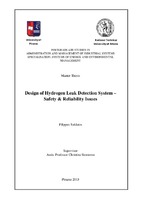| dc.description.abstractEN | Hydrogen is being widely promoted as the future primary energy carrier to replace
current hydrocarbon fuels. Governments and industries are investing in research and
development programs to develop hydrogen production, transport and storage
technologies. In addition, hydrogen gas is currently used in chemical processing and
aerospace applications. Hydrogen gas is combustible with a wide flammability range of
about 4 to 75 percent, a low ignition energy, and a low gas density. With the expanding
application of hydrogen gas coupled with its highly combustible nature, focus must be
placed on safety. Detection and monitoring technologies are needed which can provide
low limits of detection, high sensitivity, a wide detection range, fast response times and
ease of implementation to ensure public safety. Hydrogen sensors are of increasing
importance in connection with the development and expanded use of hydrogen gas as an
energy carrier and as a chemical reactant. Also they are essential to facilitate the detection
of accidental hydrogen releases wherever hydrogen will be produced, distributed, stored,
and used.
This thesis highlights the importance of hydrogen sensing regarding the safety and
reliability. The first chapter describes and classifies the different types of hydrogen
sensors and the technology behind them. Characteristic performance parameters of these
sensor types, such as measuring range, sensitivity, selectivity and response time are
reviewed.
In the second chapter the methods of the tests performed on the commercially available
hydrogen sensors are described. Parameters such us detection limits and response times
are measured and the advantages and disadvantages of those sensors are written down.
In the third chapter new hydrogen detecting technologies will be mentioned either
available in the market or under development and afterwards we will refer to the
improvements of knowledge on hydrogen safety, according to the standards and
guidelines of the International Energy Agency's Hydrogen Implementing Agreement.
Regulations will be also mentioned.
The fourth chapter describes the framework of the Hydrogen Safety Engineering
(H2SE) profession which is defined as an application of scientific and engineering
principles to the protection of life, property and environment from adverse effects of
incidents/accidents involving hydrogen. Finally a reliable and comprehensive safety risk
analysis model has been developed.
In the fifth chapter of this thesis there is a summary with the conclusions deducted of
this work. | el |



